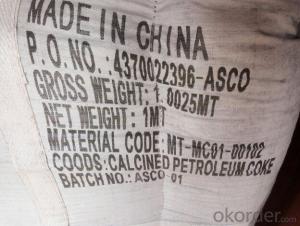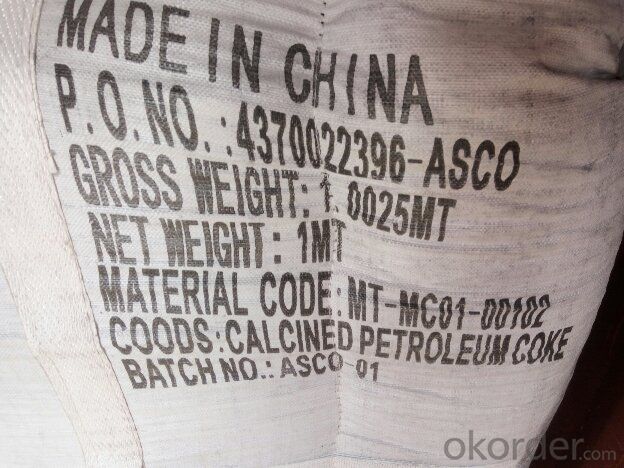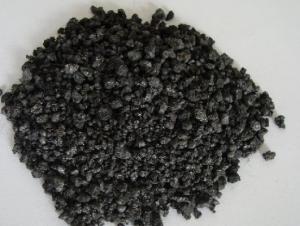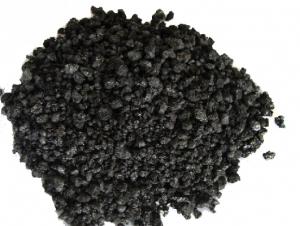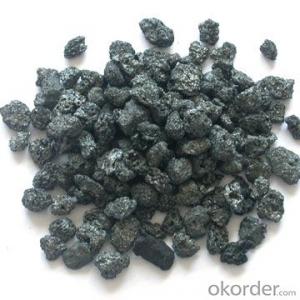Calcined Petroleum Coke with FC 98.5%min
- Loading Port:
- Shanghai
- Payment Terms:
- TT OR LC
- Min Order Qty:
- 19.7
- Supply Capability:
- 1007 m.t./month
OKorder Service Pledge
OKorder Financial Service
You Might Also Like
Intrduction
Carbon additive to ningxia production of anthracite as raw material, after washing, crushing, high temperature calcination, filter, etc. Craft refined and become.This is after the anthracite calcination generated high carbon content and low volatile component of the new product, is an ideal raw material to make steel.Steay supply
Calcined Petroleum Coke comes from delayed coke which extracted from oil refinery. Although Calcined Petroleum Coke contains a little bit higher level of sulfur and nitrogen than pitch coke, the price advantage still makes it widely used during steel-making and founding as a kind of carbon additive/carburant.
Features
In the smelting process for reducing agent. Performance: replace the traditional oil carbon additive, decrease the cost of steelmaking. Features: low ash. low sulfur,low phosphorus, high calorific value. High ratio resistance,high mechanical strength,high chemistry activity. It is mainly used for metallurgy reductant inoculants, casting, refractory materials, machinery, electronics and other fields.
1) high absorption rate, it can be absorbed up to 90%.
2) absorbed more quickly than other carbon additive; no residue remains in furnace.Good quality
3) low Sulfur, the lowest can reach below 0.20%; low nitrogen, normally below 200ppm (0.02%)
Specifications
CPC | |||
F.C.% | 98.5MIN | 98.5MIN | 98MIN |
ASH % | 0.8MAX | 0.8MAX | 1MAX |
V.M.% | 0.7 MAX | 0.7 MAX | 1 MAX |
SULFUR % | 0. 5MAX | 0. 7MAX | 1MAX |
MOISTURE % | 0.5MAX | 0.5MAX | 1MAX |
Pictures
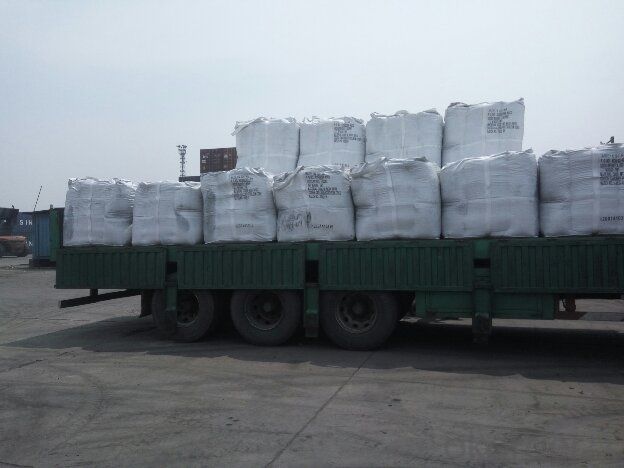
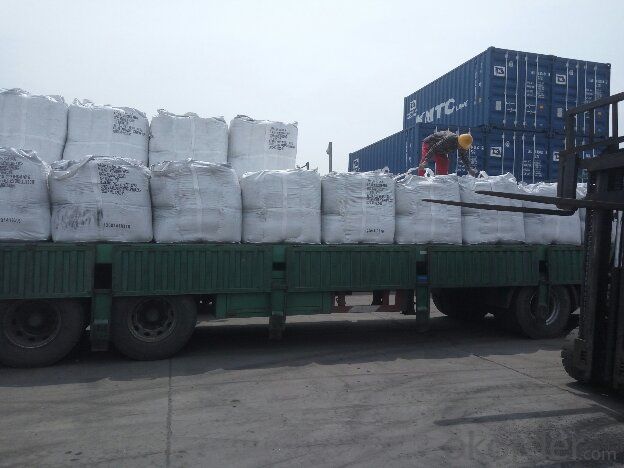
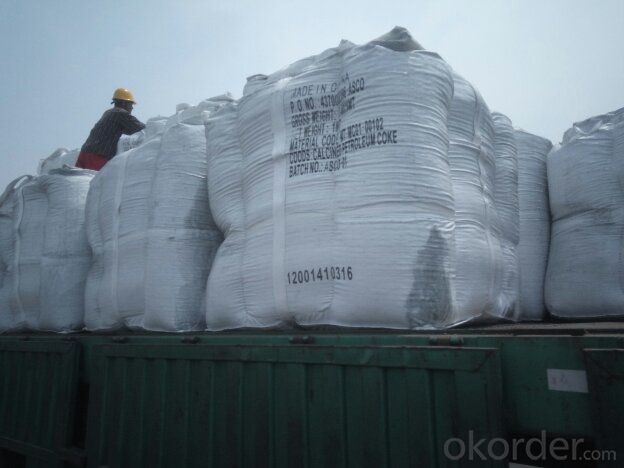
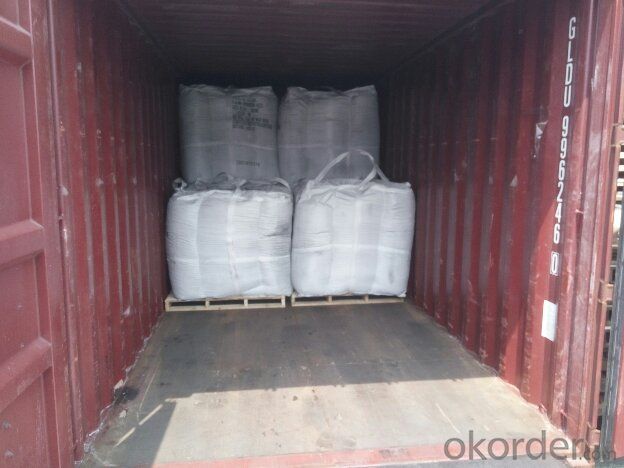
FAQ:
(1)CPC could be as fuel
Petroleum coke is a material relatively low in cost and high in heat value and carbon content with good chemical stability, making it an efficient and costeffective fuel for producing metal, brick and related products.
(2)CPC could be as Graphite Electrodes
Graphite can be produced from lowsulfur needle petroleum coke, which must be heated above 5,432 degrees Fahrenheit.
(3)CPC could be as Anodes
Calcined petroleum coke, often low in sulfur and metallic impurities, is used to make anodes for
the smelting industry.Calcined petroleum coke is mixed with coal tar pitch in the production of
anodes.
- Q: Can barbecue carbon still have the effect of absorbing formaldehyde?
- 2) activated bamboo charcoal is internationally recognized as a formaldehyde master, active bamboo charcoal masks, gas masks are activated carbon. This product uses the physical function of activated carbon, deodorization, detoxification, without any chemical additives, no impact on the human body, adsorption slow, easy to saturated. There are many kinds of active ingredients, such as coconut shell charcoal, shell charcoal, coal activated carbon and so on.
- Q: What is carbon steel, carbon manganese steel?
- Carbon manganese steel is a high-quality carbon structural steel in the higher manganese content of carbon steel, manganese elements are generally marked in the rear, such as 20Mn, 40Mn and so on
- Q: Is there any difference between carbon plate and universal board?
- Generally referred to as "Pu plate" is "hot-rolled ordinary carbon structural steel plate", usually refers to single rolled steel plate (original flat plate). The common grades are: Q235, Q345, SS400, St12 and so on.Usually referred to as "carbon tie plate" refers to the "ordinary carbon structural steel hot-rolled coil", refers to the continuous rolling process with hot rolling mill rolling, finished products are steel coil delivery of ordinary carbon steel plate (coil).
- Q: How does carbon affect the pH of rainwater?
- The pH of rainwater can be influenced by carbon, which occurs when carbon dioxide (CO2) in the atmosphere dissolves in rainwater. This process is known as the formation of carbonic acid (H2CO3). As a result of this reaction, the pH of rainwater decreases, making it more acidic. The carbonic acid breaks down into hydrogen ions (H+) and bicarbonate ions (HCO3-), which further contribute to the acidity of rainwater. Consequently, higher levels of carbon dioxide in the atmosphere, such as those caused by human activities like the combustion of fossil fuels, can result in an increase in the formation of carbonic acid and subsequently lower the pH of rainwater, leading to the occurrence of acid rain.
- Q: How does carbon impact the prevalence of avalanches?
- Carbon has a significant impact on the prevalence of avalanches. The increase in carbon emissions and subsequent global warming is leading to changes in snowpack stability, which in turn affects avalanche frequency and severity. As temperatures rise, snowfall patterns are becoming more unpredictable, with more frequent freeze-thaw cycles. This creates a weaker snowpack as the snow becomes less cohesive and more prone to sliding. Additionally, warmer temperatures cause more rain to fall instead of snow, further destabilizing the snowpack by adding weight and reducing its strength. These changes in snowpack stability increase the likelihood of avalanches occurring. Moreover, climate change also affects the timing and duration of snow accumulation. With warmer temperatures, snow melt occurs earlier, which can lead to a reduced snowpack during the peak avalanche season. This can result in a higher likelihood of triggering avalanches, as there may be a smaller buffer of stable snow to support the weight and stress of additional snowfall or human activity. Furthermore, carbon-induced climate change can alter the frequency and intensity of extreme weather events, such as heavy snowfalls or rainstorms. These events can cause rapid and significant changes in snowpack conditions, leading to an increased risk of avalanches. In summary, the impact of carbon on the prevalence of avalanches is significant. The warming climate affects snowpack stability, timing and duration of snow accumulation, and the frequency of extreme weather events, all of which contribute to an increased risk and prevalence of avalanches.
- Q: Is aluminum alloy expensive or high carbon steel expensive?
- Aluminum alloy of course, a little longer, and will be much lighter.Generally, aluminum alloy frames are much more expensive than those of high carbon steel.
- Q: How does carbon monoxide affect human health?
- Human health can be severely impacted by carbon monoxide, a highly toxic gas. When we breathe it in, carbon monoxide enters our bloodstream and binds with hemoglobin, the molecule responsible for delivering oxygen to our cells. This binding is incredibly strong and hampers the effective delivery of oxygen, resulting in a condition known as carboxyhemoglobinemia. The symptoms of carbon monoxide poisoning can vary depending on the concentration and duration of exposure. Initially, individuals may experience mild symptoms like headaches, fatigue, dizziness, and nausea. However, if exposure continues or occurs at higher concentrations, these symptoms can escalate to confusion, impaired judgment, loss of consciousness, and even death. One of the most dangerous aspects of carbon monoxide is its ability to go unnoticed, as it lacks color, odor, and taste. This makes it difficult to detect its presence without proper monitoring equipment. Carbon monoxide poisoning can arise from various sources, including faulty heating systems, poorly ventilated appliances, and running engines in enclosed spaces. Prolonged or repeated exposure to carbon monoxide can result in long-term health consequences. It can lead to neurological damage, memory loss, cognitive impairment, and even permanent brain damage. Additionally, it can worsen existing cardiovascular conditions, increasing the chances of heart attacks and strokes. To safeguard ourselves from carbon monoxide poisoning, it is crucial to ensure proper ventilation and functional carbon monoxide detectors in our homes and workplaces. Regular maintenance of appliances and heating systems is also essential to minimize the risk of leaks. Recognizing the symptoms of carbon monoxide poisoning and seeking immediate medical attention are vital in preventing severe health outcomes.
- Q: What is the carbon footprint of different activities?
- The release of greenhouse gas emissions, specifically carbon dioxide (CO2), into the atmosphere as a consequence of conducting various activities defines the carbon footprint. It gauges the impact exerted by these activities on climate change. Numerous activities contribute to our carbon footprint, encompassing transportation, energy utilization, food production, and waste management. The carbon footprint associated with each activity can significantly differ depending on factors like energy source type, technological efficiency, and individual choices. Transportation serves as a major contributor to carbon emissions, with cars, planes, and ships serving as primary sources. The employment of fossil fuels in these modes of transportation results in CO2 emissions. The carbon footprint of transportation is determined by vehicle type, fuel efficiency, and travel distance. Energy utilization stands as another significant contributor, particularly in the context of electricity generation. The burning of fossil fuels, such as coal and natural gas, for electricity production leads to the release of CO2. However, renewable energy sources such as wind, solar, and hydroelectric power exhibit a lower carbon footprint as they do not emit greenhouse gases during operation. Food production, often disregarded, possesses a substantial carbon footprint. The agricultural practices involved in cultivating, processing, packaging, and transporting food contribute to emissions. Additionally, livestock farming, notably beef and lamb, generates significant amounts of methane, a potent greenhouse gas. Waste management also contributes to carbon emissions, primarily through the decomposition of organic waste in landfills. As organic waste undergoes decomposition, it produces methane. Employing proper waste management techniques like composting and anaerobic digestion can aid in reducing these emissions. It is essential to acknowledge that the carbon footprint of activities can be diminished through a range of measures. Embracing energy-efficient technologies, opting for public transportation or carpooling, selecting renewable energy sources, adopting a more sustainable diet, and practicing proper waste management all serve as avenues for minimizing our carbon footprint. Comprehending the carbon footprint associated with diverse activities enables individuals, businesses, and governments to make well-informed decisions and undertake necessary actions to curb climate change. By reducing our carbon footprint, we can contribute to a future that is more sustainable and environmentally friendly.
- Q: How does carbon dioxide affect the Earth's climate?
- Carbon dioxide (CO2) is a greenhouse gas that plays a significant role in affecting the Earth's climate. When released into the atmosphere through natural and human activities such as deforestation, burning fossil fuels, and industrial processes, carbon dioxide traps heat from the sun and prevents it from escaping back into space. This process is commonly known as the greenhouse effect. The accumulation of carbon dioxide in the atmosphere leads to an increase in global temperatures, resulting in climate change. As CO2 levels rise, more heat is trapped, causing the Earth's average temperature to increase over time. This phenomenon is known as global warming. The consequences of increased carbon dioxide levels and subsequent climate change are far-reaching. Rising temperatures lead to the melting of glaciers and polar ice caps, which contribute to sea-level rise. This can result in coastal flooding, displacement of communities, and loss of biodiversity. Furthermore, altered weather patterns, including more frequent and intense heatwaves, droughts, and extreme weather events such as hurricanes and storms, are also linked to increased carbon dioxide levels. These events can have devastating impacts on ecosystems, agriculture, and human settlements. Moreover, elevated CO2 levels also affect the ocean's chemistry. As the oceans absorb carbon dioxide from the atmosphere, they become more acidic, a process known as ocean acidification. This poses a threat to marine life, particularly organisms with calcium carbonate shells, such as corals and shellfish. To mitigate the impacts of carbon dioxide on the Earth's climate, reducing greenhouse gas emissions is crucial. This can be achieved through transitioning to renewable energy sources, improving energy efficiency, promoting sustainable land use practices, and adopting cleaner technologies. Additionally, initiatives such as afforestation and reforestation can help absorb CO2 from the atmosphere, acting as carbon sinks. Addressing the issue of carbon dioxide and its impact on the Earth's climate is essential to safeguarding the planet's ecosystems, biodiversity, and human societies. By reducing carbon emissions, we can mitigate the effects of climate change and work towards a more sustainable future.
- Q: What are the different types of carbon-based concrete additives?
- There are several different types of carbon-based concrete additives that can enhance the performance and properties of concrete. These additives are primarily derived from carbon-based materials and can be categorized into three main types: carbon nanotubes, graphene, and carbon fibers. 1. Carbon Nanotubes: These are cylindrical structures made up of carbon atoms arranged in a unique hexagonal pattern. Carbon nanotubes have exceptional mechanical and electrical properties, making them highly desirable as concrete additives. When added to concrete, they can improve its strength, durability, and toughness. Carbon nanotubes also enhance the electrical conductivity of concrete, which is beneficial for applications such as self-healing concrete and anti-static flooring. 2. Graphene: Graphene is a single layer of carbon atoms arranged in a two-dimensional lattice. It is known for its exceptional strength, high electrical conductivity, and excellent barrier properties. When incorporated into concrete, graphene can significantly improve its mechanical properties, such as compressive strength, flexural strength, and abrasion resistance. It also enhances the durability and impermeability of concrete, providing resistance against water and chemical ingress. 3. Carbon Fibers: These are long, thin strands of carbon, typically derived from organic polymers such as polyacrylonitrile or pitch. Carbon fibers possess excellent tensile strength and are widely used as reinforcements in various construction materials, including concrete. When added to concrete, carbon fibers can enhance its flexural strength, impact resistance, and cracking behavior. They also improve the ductility and toughness of concrete, making it more resistant to dynamic loads. It is worth noting that each type of carbon-based concrete additive has its unique advantages and applications. Carbon nanotubes offer exceptional mechanical and electrical properties, graphene provides enhanced strength and barrier properties, while carbon fibers enhance flexural strength and impact resistance. The choice of additive depends on the specific requirements of the concrete application and the desired performance characteristics.
Send your message to us
Calcined Petroleum Coke with FC 98.5%min
- Loading Port:
- Shanghai
- Payment Terms:
- TT OR LC
- Min Order Qty:
- 19.7
- Supply Capability:
- 1007 m.t./month
OKorder Service Pledge
OKorder Financial Service
Similar products
Hot products
Hot Searches
Related keywords
